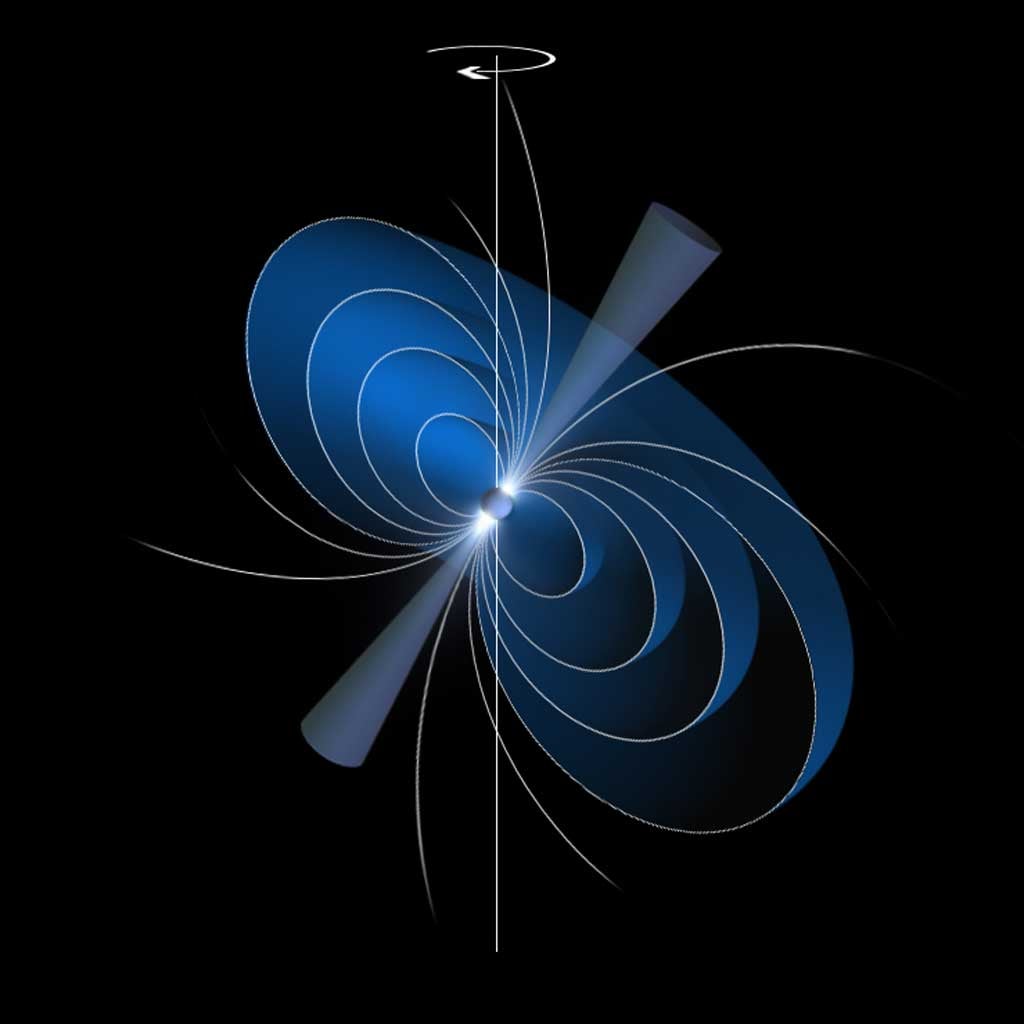Few classes of astronomical objects are as baffling as pulsars, which were discovered as flickering sources of radio waves and soon after interpreted as rapidly rotating and strongly magnetized neutron stars. Although scientists have found about 2,000 pulsars since the first was discovered in 1967, a detailed understanding of the mechanisms that power them still eludes them.
“There is a general agreement about the origin of the radio emission from pulsars: It is caused by highly energetic electrons, positrons, and ions moving along the field lines of the pulsar’s magnetic field, and we see it pulsate because the rotation and magnetic axes are misaligned,” said Wim Hermsen from the Netherlands Institute for Space Research in Utrecht. “How exactly the particles are stripped off the neutron star’s surface and accelerated to such high energy, however, is still largely unclear.”
Hermsen led a new study based on observations of the pulsar known as PSR B0943+10, which were performed simultaneously in X-rays with ESA’s XMM-Newton and in radio waves. By probing the emission from the pulsar at different wavelengths, the study had been designed to discern which of various possible physical processes take place in the vicinity of the magnetic poles of pulsars. Instead of narrowing down the possible mechanisms suggested by theory, however, the results of Hermsen’s observing campaign challenge all existing models for pulsar emission, reopening the question of how these intriguing sources are powered.
“Many pulsars have a rather erratic behavior: In the space of a few seconds, their emission becomes weaker or even disappears for a while, just to go back to the previous level after some hours,” said Hermsen. “We do not know what causes such a switch, but the fact that the pulsar keeps memory of its previous state and goes back to it suggests that it must be something fundamental.”
Recent studies indicate that the switch between what is usually referred to as “radio-bright” and “radio-quiet” states is correlated to the pulsar’s dynamics. As pulsars rotate, their spinning period slows down gradually, and in some cases, the slow-down process has been observed to accelerate and slow down again in conjunction with the pulsar switching between radio-bright and radio-quiet states. The existence of correlated variations in both the rotation and emission suggests a connection between a pulsar’s immediate vicinity and, on a grander scale, its co-rotating magnetosphere, which may extend up to about 31,100 miles (50,000 kilometers) for objects like PSR B0943+10. In order for the radio emission to vary so radically on the short time scales observed, the pulsar’s global environment must undergo a very rapid — and reversible — transformation.
“Since the switch between a pulsar’s bright and quiet states links phenomena that occur on local and global scales, a thorough understanding of this process could clarify several aspects of pulsar physics. Unfortunately, we have not yet been able to explain it,” said Hermsen.
Hermsen and his colleagues planned to search for an analogous pattern at a different wavelength — in X-rays — to investigate what causes this switching behavior. They chose as their subject PSR B0943+10, a pulsar well-known for its switching behavior at radio wavelengths and for its X-ray emission, which is brighter than might be expected for its age.
“Young pulsars shine brightly in X-rays because the surface of the neutron star is still very hot. But PSR B0943+10 is 5 million years old, which is relatively old for a pulsar. The neutron star’s surface has cooled down by then,” said Hermsen.
There are two main models that describe these processes, depending on whether the electric and magnetic fields at play allow charged particles to escape freely from the neutron star’s surface. In both cases, it is believed that the emission of X-rays follows that of radio waves, but the emission that is observed in each scenario is characterized by different temporal and spectral characteristics. By monitoring the pulsar in X-rays and radio waves at the same time, the astronomers hoped to be able to discern between the two models.
Obtaining observing time on the requested telescopes turned out to be a rather lengthy procedure. “We needed very long observations to be sure that we would record the pulsar switching back and forth between bright and quiet states several times,” said Hermsen. “So we asked for a total of 36 hours of observation with XMM-Newton. This is quite a lot of time, and it took us five years before our proposal was accepted.”
The observations were performed in late 2011. The X-ray monitoring performed with XMM-Newton was accompanied by simultaneous observations at radio waves from the Giant Metrewave Radio Telescope (GMRT) in India and the recently inaugurated Low Frequency Array (LOFAR) in the Netherlands, which was used during its commissioning phase while testing its science operations.
“The X-ray emission of pulsar PSR B0943+10 beautifully mirrors the switches that are seen at radio wavelengths, but to our surprise, the correlation between these two emissions appears to be inverse: When the source is at its brightest in radio waves, it reaches its faintest in X-rays, and vice versa,” said Hermsen.
The XMM-Newton data also show that the source pulsates in X-rays only during the X-ray-bright phase, which corresponds to the quiet state at radio wavelengths. During this phase, the X-ray emission appears to be the sum of two components: a pulsating component consisting of thermal X-rays, which is seen to switch off during the X-ray-quiet phase, and a persistent one consisting of nonthermal X-rays. Neither of the leading models for pulsar emission predicts such behavior.
“The data collected during our monitoring campaign are truly challenging our understanding of pulsars, since no current model is able to explain them,” said Hermsen. “In the second half of 2013, we plan to repeat the same study for another pulsar, PSR B1822-09, which exhibits similar radio emission properties but is characterized by a different geometrical configuration. This will allow us to study these extreme objects under different viewing angles.”
In the meantime, these observations will keep theoretical astrophysicists busy investigating possible physical mechanisms that could cause the sudden and drastic changes to the pulsar’s entire magnetosphere and result in such a curious emission.
“The unpredictable behavior of this pulsar, revealed using the great sensitivity of the telescopes on board XMM-Newton, may require a radically new approach to study the fundamental processes that power these fascinating objects,” said Norbert Schartel from ESA.











